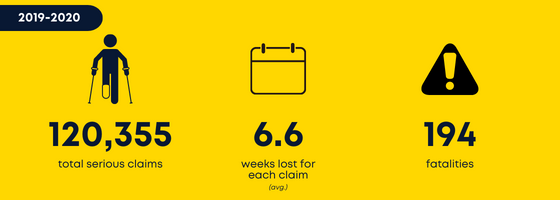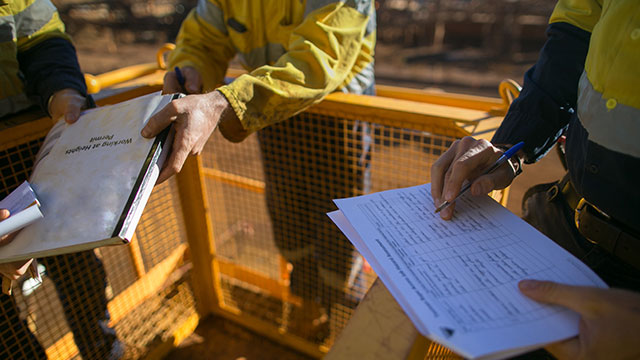Healthy and Safe Workplace
Every worker has the right to go home safe at the end of the day. To help make this happen, employers should have adequate safety documentation to manage risks. This includes risk assessments, health and safety policy statements, fire evacuation procedures and first aid protocols.
Safety documentation serves several purposes. Firstly, it ensures that employees know the risks associated with their work and how to minimise them. Secondly, it provides a clear action plan in an accident or incident. Thirdly, it helps to create a culture of safety within the workplace. By having comprehensive safety documentation in place, businesses can protect their employees and safeguard their operations.
Health and Safety Statistics
WHS statistics from Safe Work Australia show there were 120,355 total serious claims in the 2019-2020 period. With an average of 6.6 weeks lost for each claim
In 2020, there were almost 200 fatalities due to workplace injuries in Australia.
This is heartbreaking and shows just how important it is to have safety policies and procedures in place to protect workers. In the following blog, we will give you the top 5 reasons why some of these document types might be right for you.

A system-based approach
When developing WHS documents and procedures, it is important to take a system-based approach. This means identifying the hazards and risks associated with the workplace and implementing controls to minimise or eliminate those risks. The first step is to identify the hazards. This can be done through a risk assessment. Once the hazards have been identified, controls can be put in place to mitigate the risks. These controls may include administrative controls such as policies and procedures, as well as physical controls such as barriers and personal protective equipment.
It is important to evaluate the effectiveness of the controls on an ongoing basis and make changes as necessary. By taking a system-based approach to developing OHS documents and procedures, businesses can ensure that they are effectively protecting their employees from potential safety risks.
Safety Policies
Organisations with comprehensive Occupational Health and Safety (OHS) policies typically find that these policies support and complement other safety documents within the organisation.
Here are five ways OHS policies can support other safety documents:
- OHS policies can provide extended detail on specific topics covered by other safety documents. For example, a policy may provide extended detail on personal protective equipment or the procedures for reporting a hazardous condition.
- OHS policies can help to ensure that all employees are aware of the organisation's safety expectations. By clearly spelling out the expectations in a policy, there is less room for misinterpretation or confusion.
- OHS policies can serve as a resource for employees who need more information on specific safety topics. Rather than having to search multiple documents, employees can quickly refer to the relevant policy for the information they need.
- OHS policies can be updated more easily than other safety documents. Because they are typically shorter and less complex than other documents, making changes to them easier as new information becomes available is easier.
- OHS policies can help create a safety culture within an organisation. By having a clear and concise policy in place, organisations can send a strong message to employees that safety is a priority.
Standard Operating Procedures (SOPs)
SOPs are detailed instructions on how to do a particular task safely. They should be specific to your workplace and should be followed exactly. Safe work procedures can help to prevent accidents by making sure that employees know exactly what they need to do to stay safe during workplace operations.
Here are five reasons why Standard Operating Procedures (SOPs) are great for workplace health and safety:
- SOPs help ensure that everyone is on the same page regarding health and safety procedures. Having a set of standard operating procedures in place lets everyone know what is expected of them and what they need to do to stay safe.
- SOPs help to create a safer work environment by reducing the risk of human error. When everyone is following the same set of instructions, it minimises the chances of someone forgetting an important step or doing something unsafe.
- SOPs help improve communication among employees and managers regarding health and safety concerns. Having a document outlining the procedures and protocols means everyone is aligned and following the proper procedures.
- SOPs help increase workplace efficiency by ensuring everyone follows the same procedures. They help to eliminate confusion and wasted time, as everyone will know exactly what needs to be done.
- Finally, SOPs can help protect your business from liability in an accident or injury. If you can show that you have a set of written procedures in place that your employees are required to follow, it can help mitigate potential liability issues.
Safe Work Method Statements (SWMS)
Safe Work Method Statements (SWMS) outline high-risk construction activities carried out on a work site and the controls necessary to mitigate the associated safety risks. However, they are also often used outside of construction regulations. As SWMS are so useful and easy to understand, many industries utilise these documents in their day-to-day safety practices.
A SWMS aims to ensure that all workers know the risks associated with the work they will be undertaking and that suitable controls are in place to mitigate those risks. Some common risks associated with work include falls from heights, being struck by moving objects, and exposure to hazardous materials.
By outlining these risks and the controls that will be put in place to mitigate them, SWMS help ensure that construction workers can carry out their work safely and comply with regulations.
Here are five reasons why Safe Work Method Statements are great for workplace health and safety:
- SWMS help to identify potential hazards and control risks. By taking the time to assess the risks associated with a task, businesses can put in place controls to minimise the chance of an accident occurring.
- SWMS help to raise awareness of potential hazards. Employees aware of the risks involved in their work are more likely to take precautions to protect themselves.
- SWMS help to ensure that tasks are carried out safely. By clearly outlining the steps involved in a task, businesses can ensure that employees understand what they need to do to stay safe.
- SWMS help to reduce the likelihood of accidents occurring. By minimising the chances of an accident happening, businesses can save money on lost productivity and workers' compensation claims.
- SWMS help to create a culture of safety in the workplace. When employees see that their employer is committed to safety, they are more likely to follow safe work practices.
A well-designed SWMS can make a big difference to workplace safety. By taking the time to assess risks and put controls in place, businesses can create a safer environment for their employees.

Checklists
Checklists are often used in various settings to ensure that all the necessary steps are taken before moving forward with a task. This simple tool can also be extremely helpful in managing safety.
Here are five reasons why checklists are great for managing safety:
- Checklists help to break down complex tasks into manageable steps. This can be especially helpful when dealing with safety procedures that must be followed precisely.
- Checklists can help to ensure that all the necessary steps are taken before proceeding. This can help prevent accidents and injuries by ensuring everyone is on the same page.
- Checklists can help to create a culture of safety in the workplace. By using checklists, companies can send the message that safety is a priority and that everyone needs to do their part.
- Checklists can help to identify potential hazards. By thoroughly evaluating each step of a task, it is easier to identify potential hazards and take steps to mitigate them.
- Checklists can serve as a valuable training tool. They can help new employees learn the proper procedures and ensure that everyone is updated on the latest safety protocols.
Safety Management Plans
It's important to have a Safety Management Plan (SMP) in place before any high-risk activity takes place on-site. An SMP is a blueprint for conducting the activity and should include clearly defined responsibilities, timelines, and milestones. This ensures that everyone knows what to do and when to do it and minimises the chances of something going wrong.
There are different formats that Safety Management Plans can take, but all of them should cover the same basic ground.
The first step is to identify the potential hazards associated with the activity. Once the risks have been identified, steps can be taken to mitigate them. This might involve putting up barriers or signage, providing safety training, or modifying the work process. Finally, it's essential to establish clear lines of communication so that everyone knows what to do in case of an emergency.
Here are the top 5 reasons why you need a Safety Management Plan:
- A site-specific safety management plan helps ensure all risks are identified and controlled. This is especially important in high-risk environments with a potential for serious injury or even death.
- A safety management plan helps to ensure that everyone on site knows their roles and responsibilities. This transparent communication can help avoid confusion and mistakes during an emergency.
- A safety management plan helps ensure all equipment and resources are available when needed. This can help avoid delays in getting the necessary help to injured people.
- A safety management plan helps to ensure that all procedures are followed correctly. This can help avoid shortcuts that could compromise safety.
- A safety management plan provides a document that can be used as evidence of an accident or incident. This can be invaluable in demonstrating that all reasonable steps were taken to avoid the incident.
Conclusion
The importance of documenting procedures for health and safety cannot be overstated. By having a clear and concise set of instructions, businesses can ensure that their employees are appropriately trained and that potential hazards are identified and mitigated.
Furthermore, well-documented procedures can help avoid costly mistakes and accidents, which can have devastating consequences. Ultimately, taking the time to develop and implement effective health and safety procedures is an investment that will pay off in the long run.
Author - Craig Cruickshank is the HSEQ Manager and Senior Technical Advisor at SafetyDocs by SafetyCulture.
Craig comes from a construction and environmental background, with experience in both the private and public sectors and is passionate about making health and safety information easy to find and understand for everyone.
Learn more about Craig's work on LinkedIn
Available for instant download and supplied in fully editable MS Word format for use in your business.
Please note that the above information is provided as a comment only and should not be relied on as professional, legal or financial advice.
Share This Article
